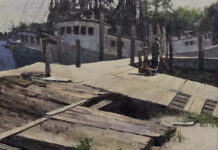
Pastelists are taking note that a master of the medium is teaching at the Plein Air Convention & Exposition (PACE) this year: Albert Handell. During a recent chat, Handell explained the intricate relationship of plein air and studio work he pursues — an approach that may surprise you.
For Handell, plein air work means relatively small pastel paintings that he sees as finished work. He may do the same scene much larger in oil in the studio, but the pastel won’t function as a reference — although the experience will. “By doing the pastels on location, I’m being exposed to the colors and the light conditions of the subject,” says Handell. “But when one works in sunlight conditions, one has many options during the three hours. In the plein air piece, one can only use one of the options. But it’s nice to be exposed to what else could have been.”

“L’Arbre (The Tree),” by Albert Handell, pastel, 12 x 18 in.
Those alternatives are what show up in his studio work. “I try to photograph those other considerations that excite me — and those photos and my personal experience will freshen the studio piece,” he says. “I rarely paint a large oil based on a pastel done on location, and the oil painting never looks like the photograph — but without the photograph, there is no painting. It’s ironic.”
Related > Albert Handell has a NEW Streamline Premium Art Video on how to paint landscapes in oil!
Handell’s facility with pastels is on good display in a piece featured here, “The Flat Irons.” The vertical crevice running through the rock falls in shadow, and Handell expertly expresses the crisp edge of the shadow to give the rock convincing form, while the snow in the shadowed crevice screams of the blue sky color, only darker. The New Mexico artist is a strong advocate for the use of pastels outdoors. “The immediacy of pastels works great with plein air,” he says. “By varying the pressure on the pastel stick, I get more than one color out of each stick. It makes the medium very fluid, and certainly very immediate.”

“The Essence of Palms,” by Albert Handell, pastel, 17 x 16 in.
The big oil paintings may sell for more and may attract a different group of collectors, but the plein air work is key. His time at a location and the chance to photograph a scene are crucial, to start. Handell clearly gets a kick out of it, too. “There are no coffee breaks,” he says. “There is no mulling it over for a day or two. It’s the freshness of looking up and responding, period.” Sometimes he executes a watercolor underpainting before going to pastels, and sometimes he works strictly in pastels. In either case, Handell blocks in big masses and slowly adds the minimum of details needed. “I never want to lose the impact of those big shapes,” he says.
Handell is big on capturing first impressions. He’s discerning, but once he thinks he has it in mind, it’s over. Consider this method of choosing subject matter: “I don’t like to drive more than 20 or 30 minutes from the studio. When I get out of the car, I am always looking. When something hits me, I stop and take that very seriously, because I feel something out there has touched something inside me. Whenever I get one of those ‘Oh, my gosh’ hits, it’s sudden and it really hits me. In the old days I used to give myself another five minutes by wristwatch to find something more perfect. But I have found that when it hits, that’s it.”

“Late Afternoon Light,” by Albert Handell, pastel, 16 x 22 in.
In other words, Handell trusts himself. It’s undoubtedly one of the reasons Handell has had the career he has enjoyed, including the recent addition of a second pastel piece to the collection of the Butler Institute of American Art in Youngstown, Ohio. At the Plein Air Convention, set for April 13-17 in Monterey, California, Handell will offer a demonstration, and the artist says he will be working from a photograph and using a watercolor underpainting for his pastel piece. Sign up for PACE today.





Thanks, but really? Plein air painters can get into serious trouble painting in locations that are private or public with restrictions. I know you know this and this was meant to show the lighter-side of what we do, BUT a “Safety First” comment would remind those new to this way of painting of potential dangers. I have seen beginning PA painters with an amazing hodge-podge of equiptment, so I know there are people who would think they can paint in safety anywhere they can park their “camper”.
seriously? paining in his underware? ridiculous!
You guys do a great job . thanks for the magazine. The besto to you for 2011.
Federico León de la Vega
More power to Robert Ferguson for painting in his skivvies – ha! I challenge him to paint outdoors in public sans clothing as I have done at Wilbur Hot Springs, a setting where naturalism is the great equalizer between the artist and model. 😀 Say, Thank you to Editor, Steve Doherty for featuring our Locke, California monthly paintouts and for placing our picture just above Robert in his underwear – he would’ve been a hard act to follow. Head west, fellow painters and help us hold up (and paint) the leaning buildings in Locke!
I have painted next to Barbara Jablonski in wind, rain and sun. She is a dedicated Plein air artist who arrives early and starts painting even when she drives 100 miles to join us at Niagara Falls or Buffalo paintouts. I live right there and have a 5 minute ride!